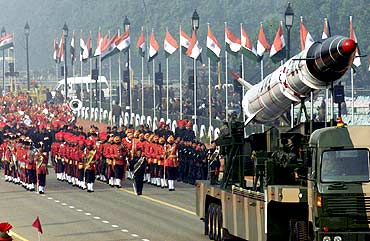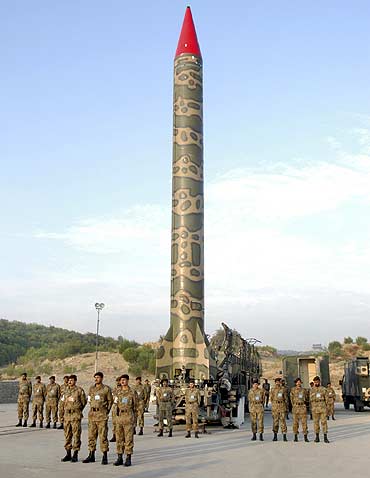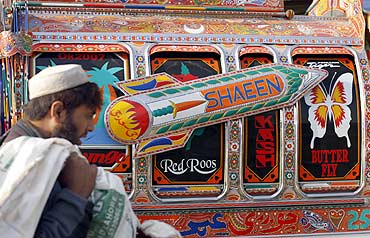Photographs: Reuters
A look at the relative strengths of India, China and Pakistan in relation to their missile arsenals and development programmes.
The recent successful test firing of the Agni-II was just the latest in a series of missile tests in the South Asian neighbourhood. In recent years, India, Pakistan and China have quietly been trying to get their nosecones ahead of each other. One tests a 2,000-kilometre range missile and the other responds with a missile that can go up to 2,200 kilometres.
With the latest Agni II test, all the three countries have each other's major cities in their crosshairs, with some missiles needing just a few minutes to reach the most far-flung of 'enemy' cities.
All three have also been developing -- or getting from friendly countries -- ballistic missile defence capabilities too. More worrying for India should be the fact that China's well-rounded arsenal is always available for Pakistan, if and when the need arises.
Here's a look at how New Delhi, Islamabad and Beijing, Asia's three nuclear states, fare in a missile face-off
Click next to find out
The fiery Agni series
Image: India's nuclear-capable Agni-III missile takes offPhotographs: Ministry of Defence/Reuters
India's stock missile is the Agni series, all of which are nuclear capable. The Agni programme has now reached its third missile, Agni-III, which is an intermediate range ballistic missile. Agni-III, despite being successfully tested, is still not operational.
Agni-III is capable of carrying nuclear warheads and striking targets upto 3,500 kilometres. India has also announced plans to test Agni-V and said that it would be operational in a couple of years. Both these missiles have been designed keeping China in mind, and can reach targets as far as Shanghai and Beijing.
Its predecessor Agni-II's trial was conducted with a special strategic command force, with a range of 2,000 kilometers, thus making it operational. With this, most of China's major cities are within India's range.
Agni-I has a range of 800 kilometres and has been operational since 1989.
Little-known Akash is India's fastest missile
Image: The Brahmos supersonic cruise missiles are displayed during the Republic Day paradePhotographs: Reuters/B Mathur
If the Agni family is India's stock missile, the BrahMos is its ace in the pack. Developed in collaboration with Russia and named after the famous Brahmaputra and Moskva rivers in the two countries, BrahMos, which has a range of 290 kilometres, is a supersonic cruise missile that can be launched from land, aircraft, ships, and submarines. Brahmos-II , with a speed of Mach 5.6, has been lab tested, and could be inducted into the Indian Army by 2013.
Despite misconceptions, BrahMos is not the fastest missile in the world. It is not even India's fastest missile. That record stays with the little-known Akash, which can go up to Mach 3.5, compared to BrahMos's current Mach 3 speed.
Akash, a surface to air missile with a range of 60 kilometres, leads the cluster of lesser-known Indian missiles.
The Prithvi family is a tactical surface-to-surface short-range ballistic missile with a range of 150-600 kilometres.
The Shaurya surface-to-surface missiles, with a range of 750-1,900 kilometres, can remain hidden in underground silos from enemy surveillance till they are fired.
Nag is a fire-and-forget anti-tank missile, with a 5-7 kilometre range, that can be fired from land and air.
Trishul is a short-range surface-to-air missile, with a 9-kilometre range. India also has Russian and Israeli missiles in its arsenal.
The two earlier Agni variants, which are in different stages of induction, can hit anywhere in Pakistan.
Pakistan's Ghauri will have entire India within its range
Image: Pakistani soldiers stand near nuclear-capable ballistic Gauri at an undisclosed locationPhotographs: Reuters/ISPR
Let us check out the missile updates in India's volatile neighbouring countries.
Pakistan, whose missile programme started in 1989, (India's started in the early 1980s) has been matching India missile-to-missile ever since.
Pakistan's first generation HATF missiles were planned to counter India's Prithvi missiles. They were built keeping in mind mostly the border region with India, where they would be effective in targeting India's weapons aimed at Pakistan. As India diversified its missile programme, Pakistan moved on to the Ghauri series, which will have entire India within its range. Experts say the main target of this series would be peninsular India.
Most Pakistani missiles have China written all over them
Image: A vehicle decorated with an image of a nuclear-capable Shaheen missile in RawalpindiPhotographs: Goran Tomasevic/Reuters
The Shaheen series, however, is Islamabad's stock missile and forms the backbone of Pakistan's nuclear deterrence. It was developed keeping in mind India's Agni series and has similar capabilities.
Babur -- a land-attack cruise missile with a range of 750 kilometres -- and the short-range Ghaznavi missiles round off Pakistan's arsenal.
India's major worry on the Pakistan front is that Islamabad, apart from having an all-weather friendship with Beijing, also can pull strings in Washington. A pointer to this fact is that when you scratch the surface of most Pakistani missiles, you will find China written all over them. The second is evident from Washington's recent decision to turn a blind eye and give a silent nod to China helping out Pakistan with nuclear technology.
of the three, China is the missile Big Brother
Image: Chinese-made Dong Feng-31 intercontinental ballistic missiles pass through Tiananmen SquarePhotographs: Reuters
While India and Pakistan have been overtly concerned with targeting and putting up defences against each other, China has gone way ahead of its neighbours, developing its missiles with one eye on the United States, which has gained a strategic presence all around China, and one on the Asian continent.
China has missiles that have Russian and Indian cities and even satellites within their range. Thus, Beijing is without doubt the Big Brother of the trio.
China also reorganised its launch facilities recently in Tibet and along its northern border with Russia.
Among China's major India-specific missiles are the Dong Feng 21. With a range of 2,500 kilometres, it is comparable to Agni-III, which is still not operational. China further has the Dong Feng 31 and Dong Feng 41, the Communist nation's long-range intercontinental ballistic missiles with a range of 8,000 to 10,000 kilometres. India is far from developing even its limited intercontinental ballistic missile, Agni-V, which will have a range of 5,000 kilometres.
What will have India most worried is China's growing militarisation of the Tibetan region, which means that most of north India is within easy range of the Chinese missile system.
Even China's missile defence is the best
Image: Paramilitary recruits form a heart pattern to celebrate the Chinese Lunar New YearPhotographs: Reuters
When it comes to defence systems, China is again in the forefront. When it smashed an ageing satellite, the world sat up and took notice. But India has been aware of the possible threat from China and has been paying a lot of attention to its defence system.
Apart from building an anti-satellite system a la China, India has also been working on interceptor and shield technologies. As often is the case, in response, Pakistan is looking towards China for a missile defence system.
Thus in the end, till the time India leapfrogs China in terms of technology, it will always have both its enemies snapping at its heels, thanks to China's benevolence to Pakistan.








article